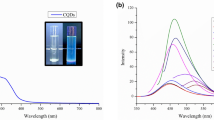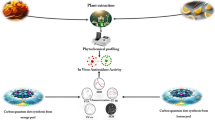Abstract
Carbon nanodots (CNDs) are 0D quasi-spherical nanoparticles that are less than 10 nm in size. CNDs that possess surface functional groups such as hydroxyl, amino, and carboxyl groups have been demonstrated to scavenge free radicals efficiently and effectively, resulting in them being beneficial for cosmetic and cosmeceutical applications. In this study, we successfully prepared novel CNDs, namely black VC, using vitamin C (VC) as a promising precursor. Black VC was prepared by a facile one-step method based on short-time microwave irradiation. The properties of black VC were characterized by transmission electron microscopy (TEM) analysis, X-ray diffraction (XRD), high-resolution X-ray photoelectron spectroscopy (XPS), Fourier transform infrared (FTIR) spectroscopy, and UV–vis spectrophotometry. Radical scavenging, cell viability, and anti-pollution activity assays were also conducted to demonstrate the functionalities of black VC. The developed black VC exhibited lower cytotoxicity and better antioxidant, metal chelating ability, and anti-pollution activities than its precursor. These results provide a new approach for developing advanced antioxidants for innovative cosmetic formulations using a simple microwave treatment method. However, black VC retained some problems of its precursor in the form of low stability, which is likely to be a challenge for its cosmeceutical application.
Graphical abstract









Similar content being viewed by others
References
Silva JCGEd, Goncalves HMR (2011) Analytical and bioanalytical applications of carbon dots. TrAC Trends Anal Chem 30:1327–1336
Velmurugan P, Kumar RV, Sivakumar S, Ravi AV (2022) Fabrication of blue fluorescent carbon quantum dots using green carbon precursor Psidium guajava leaf extract and its application in water treatment. Carbon Lett 32:119–129
Deka MJ, Chowdhury D, Nath BK (2022) Recent development of modified fluorescent carbon quantum dots-based fluorescence sensors for food quality assessment. Carbon Lett 32:1131–1149
Jana J, Hur SH (2021) Concentration-dependent emission of nitrogen-doped carbon dots and its use in hazardous metal-ion detection. Carbon Lett 31:523–536
Oskueyan G, Mansour Lakouraj M, Mahyari M (2021) Fabrication of polyaniline–carrot derived carbon dots/polypyrrole–graphene nanocomposite for wide potential window supercapacitor. Carbon Lett 31:269–276
Li J, Wang B, Zhang H, Yu J (2019) Carbon dots-in-matrix boosting intriguing luminescence properties and applications. Small 2019:1805504
Algarra M, Perez-Martın M, Cifuentes-Rueda M, Jimenez-Jimenez J, Silva JCGEd, Bandosz TJ, Rodrıguez-Castellon E, Navarrete JTL, Casado J (2014) Carbon dots obtained using hydrothermal treatment of formaldehyde. Cell Imag in vitro Nanoscale 6:9071–9077
Goei R, Tan FTF, Ong AJ, Mandler D, Tok AIY (2022) Development of nitrogen-decorated carbon dots (NCDs) thermally conductive film for windows application. Carbon Lett 32:1065–1072
Verma SK, Das AK, Gantait S, Panwar Y, Kumar V, Brestic M (2022) Green synthesis of carbon-based nanomaterials and their applications in various sectors: a topical review. Carbon Lett 32:365–393
Wang Y, Hu A (2014) Carbon quantum dots: synthesis, properties and applications. J Mater Chem C 2:6921–6939
Li D, Na X, Wang H, Xie Y, Cong S, Song Y, Xu X, Zhu BW, Tan M (2018) Fluorescent carbon dots derived from maillard reaction products: Their properties, biodistribution, cytotoxicity, and antioxidant activity. J Agric Food Chem 66:1569–1575
Christensen IL, Sun YP, Juzenas P (2011) Carbon dots as antioxidants and prooxidants. J Biomed Nanotechnol 7:667–676
Wang F, Pang S, Wang L, Li Q, Kreiter M, Liu CY (2010) One-step synthesis of highly luminescent carbon dots in noncoordinating solvents. Chem Mater 22:4528–4530
Yang X, Zhuo Y, Zhu S, Luo Y, Feng Y, Dou Y (2014) Novel and green synthesis of high-fluorescent carbon dots originated from honey for sensing and imaging. Biosens Bioelectron 60:292–298
Mazzier D, Favaro M, Agnoli S, Silvestrini S, Granozzi G, Maggini M, Moretto A (2014) Synthesis of luminescent 3D microstructures formed by carbon quantum dots and their self-assembly properties. Chem Commun 50:6592–6595
Bhaisare ML, Talib A, Khan MS, Pandey S, Wu HF (2015) Synthesis of fluorescent carbon dots via microwave carbonization of citric acid in presence of tetraoctylammonium ion, and their application to cellular bioimaging. Microchim Acta 182:2173–2181
Zhang B, Liu CY, Liu Y (2010) A novel one-step approach to synthesize fluorescent carbon nanoparticles. Eur J Inorg Chem 2010:4411–4414
Zhao P, Zhu L (2018) Dispersibility of carbon dots in aqueous and/or organic solvents. Chem Commun 54:5401–5406
Tran VV, Nguyen TL, Moon JY, Lee YC (2019) Core-shell materials, lipid particles and nanoemulsions, for delivery of active anti-oxidants in cosmetics applications: challenges and development strategies. Chem Eng J 368:88–114
Moon JY, Ngoc LTN, Chae M, Tran VV, Lee YC (2020) Effects of microwave-assisted opuntia humifusa extract in inhibiting the impacts of particulate matter on human keratinocyte skin cell. Antioxidants 9:271
Brand-Williams W, Cuvelier ME, Berset C (1995) Use of a free radical method to evaluate antioxidant activity. LWT-Food Sci Technol 28:25–30
Smirnoff N, Cumbes QJ (1989) Hydroxyl radical scavenging activity of compatible solutes Phyrochemrstry 28:1057–1060
Boukamp P, Petrussevska RT, Breitkreutz D, Hornung J, Markham A, Fusenig NE (1988) Normal keratinization in a spontaneously immortalized aneuploid human keratinocyte cell line. J Cell Biol 106:761–771
Masters JRW (2000) Animal cell culture : a practical approach. Oxford University Press, New York
Chun HS, Park D, Eun Lim S, Jeong KH, Park JS, Park HJ, Kang S, Kang KS, Park HG, An HR, Huh YS, Lee YC (2017) Two zinc-aminoclays’ in-vitro cytotoxicity assessment in HeLa cells and in-vivo embryotoxicity assay in zebrafish. Ecotoxicol Environ Saf 137:103–112
Ranke J, Molter K, Stock F, Bottin-Weber U, Poczobutt J, Hoffmann J, Ondruschk B, Filser J, Jastorff B (2004) Biological effects of imidazolium ionic liquids with varying chain lengths in acute Vibrio fischeri and WST-1 cell viability assays. Ecotoxicol Environ Saf 58:396–404
Zhu C, Zhai J, Dong S (2012) Bifunctional fluorescent carbon nanodots: green synthesis via soy milk and application as metal-free electrocatalysts for oxygen reduction. Chem Commun 48:9367–9369
Sugiarti S, Darmawan N (2015) Synthesis of fluorescence carbon nanoparticles from ascorbic acid. Indones J Chem 15:141–145
Parvin N, Mandal TK (2016) Synthesis of a highly fluorescence nitrogen-doped carbon quantum dots bioimaging probe and its in vivo clearance and printing applications. RSC Adv 6:18134–18140
Chen G, Wu S, Hui L, Zhao Y, Ye J, Tan Z, Zeng W, Tao Z, Yang L, Zhu Y (2016) Assembling carbon quantum dots to a layered carbon for high-density supercapacitor electrodes. Sci Rep 6:19028
Chen QL, Ji WQ, Chen S (2016) Direct synthesis of multicolor fluorescent hollow carbon spheres encapsulating enriched carbon dots. Sci Rep 6:19382
Mintz KJ, Bartoli M, Rovere M, Zhou Y, Hettiarachchi SD, Paudyal S, Chen J, Domena JB, Liyanage PY, Sampson R, Khadka D, Pandey RR, Huang S, Chusuei CC, Tagliaferro A, Leblanc RM (2021) A deep investigation into the structure of carbon dots. Carbon 173:433–447
Martins AC, Pezoti O, Cazetta AL, Bedin KC, Yamazaki DAS, Bandoch GFG, Asefa T, Visentainer JV, Almeida VC (2015) Removal of tetracycline by NaOH-activated carbon produced from macadamia nut shells: Kinetic and equilibrium studies. Chem Eng J 260:291–299
Flora SJS, Pachauri V (2010) Chelation in metal intoxication. Int J Environ Res Public Health 7:2745–2788
Yuan JP, Chen F (1998) Degradation of ascorbic acid in aqueous solution. J Agric Food Chem 46:5078–5082
Mujika JI, Matxain JM (2013) Theoretical study of the pH-dependent antioxidant properties of vitamin C. J Mol Model 19:1945–1952
Piao MJ, Ahn MJ, Kang KA, Ryu YS, Hyun YJ, Shilnikova K, Zhen AX, Jeong JW, Choi YH, Kang HK, Koh YS, Hyun JW (2018) Particulate matter 2.5 damages skin cells by inducing oxidative stress, subcellular organelle dysfunction, and apoptosis. Arch Toxicol 92:2077–2091
Mistry N (2017) Guidelines for formulating anti-pollution products. Cosmetics 4:57
Tran VV, Moon JY, Lee YC. Liposomes for delivery of antioxidants in cosmeceuticals: Challenges and development strategies. J. Control. Release 300:114–140.
Acknowledgements
This work was supported by the Basic Science Research Program through the National Research Foundation of Korea funded by the Ministry of Education (2021R1F1A1047906) and by the Basic Science Research Capacity Enhancement Project through the Korea Basic Science Institute (National Research Facilities and Equipment Center) grant funded by the Ministry of Education (2019R1A6C1010016).
Author information
Authors and Affiliations
Contributions
Conceptualization, V.V.T, J.-Y.M., Y.-C. L.; data curation, V.V.T.; writing original draft preparation, V. V. T.; writing review and editing, V.V.T and J.-Y. M, Y.-C.L: funding acquisition; Y.C.-L. All the authors have read and agreed to the published version of the manuscript.
Corresponding authors
Ethics declarations
Conflict of interest
The authors declare that they have no conflict of interest.
Additional information
Publisher's Note
Springer Nature remains neutral with regard to jurisdictional claims in published maps and institutional affiliations.
Supplementary Information
Below is the link to the electronic supplementary material.
Rights and permissions
Springer Nature or its licensor (e.g. a society or other partner) holds exclusive rights to this article under a publishing agreement with the author(s) or other rightsholder(s); author self-archiving of the accepted manuscript version of this article is solely governed by the terms of such publishing agreement and applicable law.
About this article
Cite this article
Van Tran, V., Moon, J. & Lee, YC. Facile approach to preparation of novel black vitamin C using microwave treatment: characteristics, antioxidant activity, and anti-pollution properties. Carbon Lett. 33, 431–442 (2023). https://doi.org/10.1007/s42823-022-00431-w
Received:
Revised:
Accepted:
Published:
Issue Date:
DOI: https://doi.org/10.1007/s42823-022-00431-w




